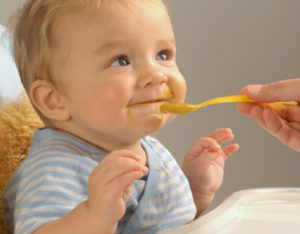A big thank you to Morag Peers who has shared her experience of weaning her babies onto solid food – a great read. Thank you for sharing Morag!

The conflicting advice stems from the fact that the guidelines on introducing solids have changed considerably in recent years. When our mothers were weaning us, the standard advice was 12 weeks or 12 pounds in weight, whichever milestone the baby reached first.
A substantial body of research has however proved that such early introduction of solids can lead to digestive and gut problems for the baby later in life. Current advice is to wait until around six months before starting to introduce solid foods to your baby’s diet.
Guidelines on Introduction of Solids
I started weaning my first baby at around 24 weeks, and like most new mums spent hours in the kitchen diligently pureeing up carrots, potatoes and apples, and freezing them in sterilized ice cube trays. At meal times I would pop out a couple of cubes, defrost them, and feed them to the baby. He seemed to like it, although the first time I changed a nappy after he’d eaten carrot was a bit of a shock to say the least. The main rule if starting weaning before the six months mark is to stay clear of anything containing gluten (pasta, bread, some cereals) and to stick to fruit and veg. Once the baby is around six months, you can safely introduce bread and other cereals such as rice, and dairy products.
At this stage, it is really important to remember that although your baby is enjoying their first tastes of solids, the main part of their diet should still be breastmilk or formula milk. Fish and chicken can also be introduced at around six months, but most parents choose to wait a while to introduce red meat as it doesn’t puree up easily. Between six and twelve months, your baby will develop rapidly, and be open to trying new things so don’t be afraid to experiment. The only food which should be avoided is honey, due to an extremely small risk of contracting botulism.
Baby Led Weaning
I quite enjoyed all the pureeing and freezing with my first baby, but when my daughter came along and I had both a baby and a toddler to deal with all day, constant cooking and freezing didn’t seem so appealing. At the time there was much discussion about a new method of introducing solids called “Baby Led Weaning” and we decided to give it a go.
Baby led weaning is based on the principle that a baby should control what it puts in its mouth, and should feed itself rather than being spoon fed. It sounded perfect for us and so we decided to give it a go. When my daughter was around 26 weeks old we started by sitting her in her chair at the table when we were all eating, and giving her some small pieces of steamed carrot, breadsticks, peas, bits of cheese or chunks of pasta to play with.
Mostly she just mushed them around on the tray, but watching us gave her the idea that she should put them in her mouth and chew. It didn’t take her long to get the hang of it, and before long she was wolfing down nearly everything we put in front of her.
Advantages and disadvantages
The main advantage of the baby led approach is that you don’t have to cook a separate meal for the baby. Babies can have what the rest of the family is having, as long as you cook without adding salt. It also means babies are introduced to a wider range of tastes and textures. The main disadvantage is the mess. Babies will throw stuff about and you have to be relaxed about this, at least for the first few weeks.”
